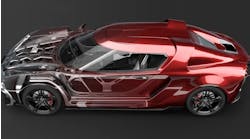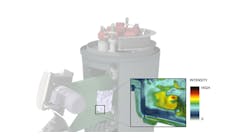No-Code Robot Interfacing
Next-Gen Robotics Control
FM&T's 2024 Guide to Exhibitors
Shot Blasting Simulations Lower Costs
Digitalizing Shot Blasting
Digitalizing Shot Blasting
The latest version of VOLUME GRAPHICS’ high-end CT data analysis software suite, version 3.5, improves manufacturers’ ability to inspect parts and improve designs, including for automotive, aerospace, and defense manufacturing, or for new materials and manufacturing methods. Such applications often engage CT scanning to achieve a more accurate, non-destructive evaluation of product robustness and performance. Volume Graphics develops software that interprets CT data from scans of almost any material to detect, analyze, and visualize minute structural deviations that might affect part quality.
Version 3.5 provides powerful automated design-geometry adjustment and repair tools that can be used to correct and/or offset issues that stem from the manufacturing process itself. Moldmakers, foundries and diecasters, and additive manufacturing (3D printing) providers can use the software to detect and visualize material and/or design defects or distortions—and then apply the available functions to correct the CAD designs, compare values against nominal limits, and ensure that final part quality meets applicable industry standards.
Volume Graphics’ CT data analysis software suite includes VGSTUDIO MAX, VGSTUDIO, VGMETROLOGY, VGinLINE, and myVGL. Some of the highlights of v3.5 include:
• A Reworked Manufacturing Geometry Correction Module. This software module benefits any operation working with molds, i.e., foundries, diecasters, injection molders. Enhancements in usability, with continuous updating and feedback on quality, give the CAD designer valuable information that can be used to improve manufacturability. Filtering out points that can cause erroneous compensation results, the software fine-tunes surface fitting and provides compensations that are within tolerances, so the user can see immediately if their design changes are compatible with mold-making.
• Enhanced Mesh Compensation. For those working in simulation and AM/3D printing, this module now provides easier navigation and understanding of the relationships between elements for better interpretation of part warpage, deformation, and displacement — and automatically compensates designs to correct for such deviations from manufacturing intent. Mesh updating is 10X faster, with improved results when scan and reference objects differ greatly in size or show other significant deviations. There are a greater number of control points for more granular and accurate results.
In the case of lattice structures and other complex geometries, a uniform control-point placement function ensures full analysis of a design. The software can also shorten the 3D-print-and-test process by automatically running two sequential design-compensation results to move a design for AM closer to nominal before the first print.
• New Porosity and Inclusion Analysis of Castings. One of the most significant features in v3.5 allows CT scanning of cast parts for porosity and to inspect for compliance with Reference Sheet P 203 of the Federation of German Foundry Industry (BDG). With the help of the BDG P 203 porosity key, users can perform a 3D evaluation of detected volume deficits both in the complete casting and in freely defined sub-areas, such as functional areas with special attributes.
The software allows inspection of multiple, different regions of interest in a part to see if porosity is within tolerances, and whether there are any post-machining issues in the finished part. The data from this analysis is then ready for Q-DAS process control.
Capability enhancements support engineering across many industries Other enhancements in version 3.5 strengthen existing functionalities that support science, R&D, medical device development and other industries in addition to automotive and aerospace & defense. Among these is advanced reporting, which is now more user-friendly and fully integrated with viewing.
The powerful nominal/actual comparison module has been made more user-friendly with easy-to-understand visualization of deviations of scanned objects from their reference data sets. For a full list and explanation of all the new developments, please see dedicated web pages for VGSTUDIO MAX 3.5, VGSTUDIO 3.5, VGMETROLOGY 3.5, and VGinLINE 3.5.
Learn more at www.volumegraphics.com








